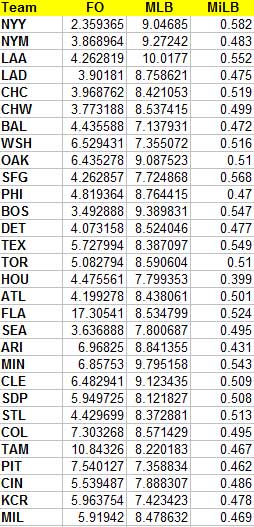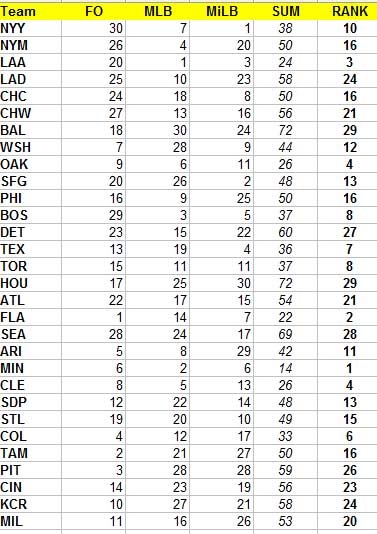Here is the basic premise and it is a good one: there are lists all over baseball about the best minor league systems, about the best front offices, etc.; can we have a single list to combine them all and look at a ranking of the best organizations with our eyes looking at the future and see which are more likely to succeed.
Cool. Home run. Touch them all, Dave Cameron!
But the task seemed too daunting, especially since count down after count down and comment after comment from fans who thought that their organizations were ranked too low, Dave got tired of the criticism and shouted: if you’re one of the 0.1% actually leaving intelligent responses in the comments section, I’m sorry, but for obvious reasons, they’re getting lost in the noise of the masses, when he presented his twelfth ranked franchise. I am sure that there is a lot of thought that went into this and a lot of work, but the problem here is that Dave's criteria were not well defined from the beginning and they were subjective. That opened the door for arguments of the nature I think that the major league talent of the Orioles is B-, why did you rank it as a C? (just a fictional example and the comments were not all that benign.) All that causes frustration to everyone involved; but I think that such condescending remarks do not help one's argument or credibility for that matter (the latest Pope tried that last week in Africa when he claimed that the use of condoms does not prevent HIV infection, but praying does, and it had a similar effect, albeit of different gravity and importance)
Back to the old ball game: How would one go about making such a ranking of franchises without causing all of that drama?
By using objective criteria.
Dave uses four criteria in his evaluations: Ownership, Front Office, Major League Talent and Minor League Talent. Since those things were not defined, and they are so intertwined, I have a hard time differentiating between front office and ownership. If a player is signed or not, is it because of a front office move or because of the owner? If a team decides to rebuilt, is that front office- or owner-driven? Hard to make this distinction. And I opted not to make it.
My criteria are three:
Front Office (includes ownership), Major League Talent, Minor League Talent.
How does one create objective measurements for these? Here is my take:
- Front Office: The idea is to create a winning team spending the least amount possible. The metric I am using for this is the sum of a team's wins the last three years (multiplied by 5 to emphasize that wins matter more than payroll; and because I do not want to penalize the teams who have it and spent it to create a winner; see: Yankees) over what the team spent as player payroll to get those wins
- Major League Talent: Remember this is forward-looking. My measurement for this is the sum of a team's wins in the last three years (multiplied by 2 to add more weight to wins, because that's what it matters) over the average age of the team's hitters and pitchers in 2008
- Minor League Talent: This was probably the easiest thing to calculate. I am using the overall winning percentage of an organization's minor league teams in 2008. Top prospects and minor league stars are great, but organizational depth is very undervalued and those are the guys who would potentially bail out a team if its starting shortstop has a finger caught in a base (sounds familiar?)
That said, here are the raw numbers for each of these categories

and here is the ranking on each of these categories (and their overall ranking; if it is not clear I added the component rankings and ranked the lowest total as number one and so forth, to calculate overall rankings)

based on these criteria, the baseball organizations would rank as follows:
1. Twins
2. Marlins
3. Angels
4. Indians, Athletics
6. Rockies
7. Rangers
8. Blue Jays, Red Sox
10. Yankees
11. Diamondbacks
12. Nationals
13. Padres, Giants
15. Cardinals
16. Rays, Mets, Cubs, Philies
20. Brewers
21. White Sox, Braves
22. Reds
24. Dodgers, Royals
26. Pirates
27. Tigers
28. Mariners
29. Orioles, Astros
Discussion is always welcomed and appreciated. Please ask questions about the methodology and challenge the metrics. I could have used more verbage to describe more of what I am thinking, but this is long as is. I'd love to explain gray areas in questions. This is just an exercise at this point and I will try to do it annually, since the numbers will change annually. And there are a couple of





3 comments:
Major League Talent - I like the idea of using age. Makes sense from a 'forward looking' point of view.
Have to look at this more carefully later, but this is really fun.
Thanks thry.
Thanks, Marv. This kind of things are somewhat interesting exercises (you should have a look at Dave Cameron's at FanGraphs for reference), but I am not sure whether there is a lot of benefit, since they really do not have much descriptive or predictive value :)
Just a list...
Any organizational ranking that has Tampa at 16, Yankees at 10, and the Marlins ahead of the Red Sox is clearly not one with any value. Sorry guy. Interesting thought, though.
Post a Comment